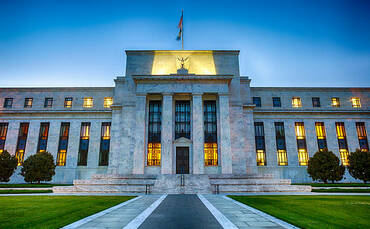The move came as widely expected by the markets, leaving the central bank's rate target at 5.25%-5.5%, a 22-year high and bolstering expectations that the Bank of England will also maintain rates later today (2 November).
This came despite the US economy exceeding with strong job growth and economic expansion, but the inflation rate remains above the Fed's 2% target.
In a statement on Wednesday (1 November), the Fed said the decision to hold rates had been unanimous, adding that the rate-setting committee would be prepared to adjust the stance of monetary policy "as appropriate" if risks emerge.
US GDP beats expectations at 4.9% in Q3
The committee also said that leaving rates unchanged would give the central bank to continue to assess additional information and its implications for monetary policy.
The Fed also said it would be taking into account the "cumulative tightening of monetary policy", the lags with which monetary policy affects economic activity and inflation, and economic and financial developments.
In a press conference, chair Jerome Powell said a few months of strong economic data is "only the beginning" of gaining confidence that inflation is heading towards its target, adding that the process of getting inflation down to target has "a long way to go".
"Despite elevated inflation, longer-term inflation expectations appear to remain well anchored, as reflected in a broad range of surveys of households, businesses, and forecasters, as well as measures from financial markets," he said.
High bar for further hikes
Seema Shah, chief global strategist at Principal Asset Management, said that the Fed's emphasis on financial conditions weighing on the economy is potentially a signal that the central bank has "minimal appetite" to raise rates further.
However, she said that with the economy still so hot and inflation deceleration potentially hitting "a road bump", an overly dovish approach from Powell may risk a resurgence in inflation pressures.
"Powell has a careful balancing act ahead of him - not just today but for the coming months," she added.
ECB meets expectations as rates held at 4%
Salman Ahmed, global head of macro and strategic asset allocation at Fidelity International, said the bar for additional hikes this cycle remains high, given tighter financial conditions due to a climb in longer-term rates.
But he also argued that it "will not take much" for the Fed to change its stance here and return to the dot plot if data flows continue to show strength in the coming weeks.
"We may be nearly done with hikes in this cycle, but the Fed is not yet ready to signal that," he said.
Other experts believe the hike in July may have been the last one for the Fed. George Lagarias, chief economist at Mazars, said it is "difficult" to see how the central bank will hike again in this cycle.
"Given the easing in oil prices and the precipitous climb in long-term rates, it is more likely than not that the Fed's next move will be a rate cut, however long it takes," he said.
Federal Reserve and BoE expected to end hiking cycle this week despite persistent inflation
Whitney Watson, co-head and co-CIO of fixed income and liquidity solutions at Goldman Sachs Asset Management, said Wednesday's decision presents risks in both directions.
"The rise in inflation expectations, owing to higher gas prices, combined with strong activity, preserves the prospect of another rate hike," she said.
"Conversely, a more pronounced economic slowdown caused by the growing impact of higher interest rates might accelerate the timeline for transitioning to rate cuts."


